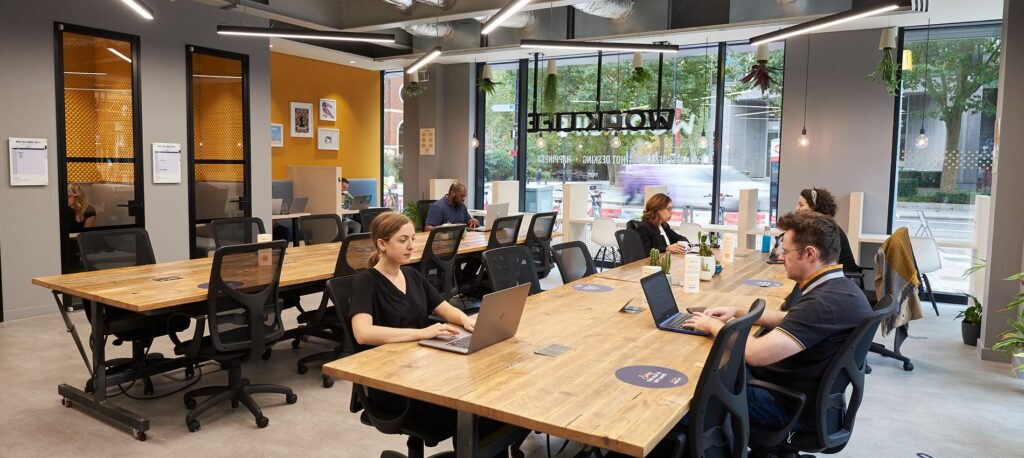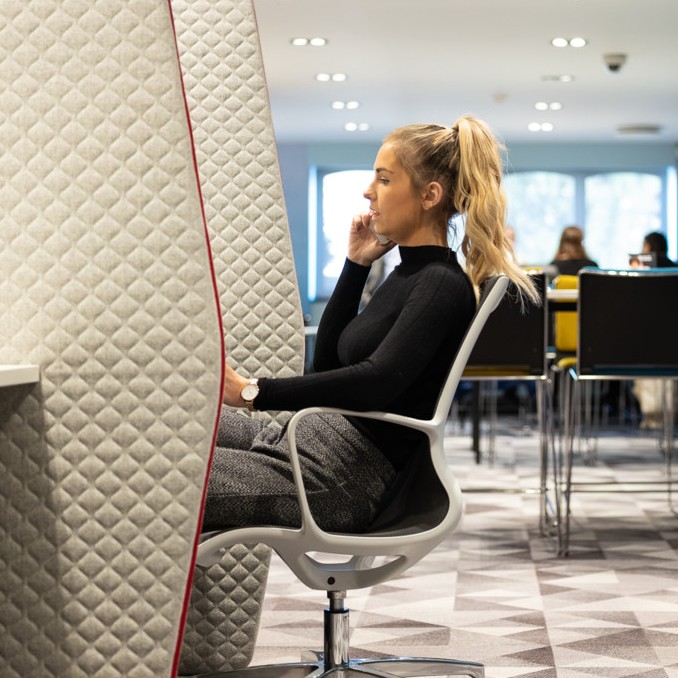The pandemic has proven that not being in an office does not come at the expense of productivity and there has been a significant shift in the way we work. Businesses of all sizes are now exploring options on how their staff will work from now on. The options can be anything along the spectrum of returning to the office on one end and fully remote on the other end. In between these two are several degrees of hybrid working.
“One employee-one desk” is no longer the only office space solution
With more employees keen to work remotely more regularly, the traditional, “one desk per employee” approach is no longer the best or most cost-efficient option for everyone. Unfortunately, there’s no absolute solution. At Othership, we believe that every organisation should have its own unique workplace solution, with employees working across three main types of space: their company HQ, home, and on-demand workspaces. How it will look in reality depends on the requirements of the business and it can be anything from a traditional office workplace to a hybrid office.
If you need help working out what your configuration should look like, feel free to book a call with one of our hybrid workplace experts.
Once you’ve established what your workplace strategy should be, you will need to match it with a viable workplace solution. What does that mean in your case? Do you keep your existing office or do you downsize it? De-centralise? Ditch it all together and go fully remote?
We’ve collated the hybrid workplace options available out there in this guide to help you find the best approach for your business and your team.
Desk bookings, meeting room bookings and global wayfinding
There have long been desk and meeting room booking tools out there. Since the 2018 Global Pandemic, the rapid change in working practices to hybrid meant these tools became a necessity in the Safety section of Maslow’s hierarchy of office needs. However, as Maslow told us, there are much higher needs.
You can now find tools such as Othership’s Hybrid Workspace Management Software (HWMS) that will let you achieve the Social, Esteem and Self-Actualisation echelons of the hierarchy.

Othership Hybrid Workplace Management Software
By enabling employees to not just only see who’s in the office and decide when to come, employees and individuals can now find each other anywhere in the world. This means they can work from anywhere without the isolation or lack of collaboration that people have experienced thus far, or at least do away with the flooded WhatsApp chats, Slack and Teams messages on where you are this week.
Organisations can now manage their real estate in a manner that allows them to be highly flexible. Knowing whose using what sort of spaces in your own building helps manage spend on unnecessary office space. Companies such as Othership will allow you to promote your underutilised space by offering coworking and Private Offices for purchase through their platform.
Organisations can make further gains by encouraging strong employee experience when colleagues can easily find coworkers anywhere in the world. Imagine turning up at event, or working away for a week and knowing you had two colleagues in the city and a space to meet and work for free. When the data shows that a number of people are meeting regularly to work, it may be time for a small office in a coworking space – DropBox Studio style.
Fully remote
With this workplace solution, a company does not have a formal office. Every employee from interns to C-level-management and directors are remote workers. Some define it as “working from home”, others take a work-from-anywhere (WFA) approach. They use this opportunity for workcations and longer trips abroad. Business owners and HR managers should consider a few aspects for a remote-first company.
Apart from technology to facilitate remote team collaboration, the HR policies for remote work should define where employees are allowed to work from and where not, e.g. within the UK or abroad, from home or from anywhere. Insurance and tax regulations are important in this approach. Employees certainly appreciate an allowance for a home office set up to remove the need for sofa working or the kitchen table office.

Photo by Andrea Piacquadio
On-demand access to workspaces
An allowance to purchase a desk, an ergonomic chair or a separate screen is a great gesture, but it might not be what employees want. Not everybody enjoys the full-time home office and would rather work from a café or a coworking space.
There is a solution for these employees too via memberships for on-demand workspaces. Each employee could decide where they would like to work from on any given day. This could be a coffee shop around the corner or near the nursery where they pick-up their children or a coworking space in town.
To support such initiatives, we’ve created an on-demand Premium Membership. At Othership, this means a few hundred workspaces all across the UK by the hour or daily. Employees in London can benefit from the same package than employees in Manchester or Edinburgh.
What to watch out for if you’re comparing on-demand coworking services:
- Limited number of bookings in some spaces – Some providers will not let employees book workspaces more than a few times.
- Coworking credits – The illusion of simplicity to lure you. In general, coworking credits are used to hide the cost of day passes so a markup can be added. At Othership, not only are we transparent with day passes pricing, but we negotiate 25% to 50% off. See the list of coworking spaces with 25 to 50% off here.
- Minimum monthly purchase – Some providers will also require a minimum monthly amount purchased per employee. You will almost never get value for money.
- Guest bookings – Some providers won’t allow guest bookings at all. You guess what our policy is here!
Workspace allowances
A similar approach to on-demand workspaces is a workspace allowance for employees. Instead of taking a membership for them, the employer leaves the decision to their staff. Each team member can decide what to use the workspace allowance for. It could be an on-demand membership or the rent of a fixed desk in a coworking space or any other option that works for the individual team member.

Work.Life Hammersmith
Multi-location office memberships
This hybrid workplace solution works in a similar way as the on-demand membership but focuses on office networks. The offices are in different locations and it is usually one office space provider who manages them all.
This is at the same time a restriction: Such memberships usually offer a wide range of locations, but they still aren’t everywhere. Before a company signs up for such a solution with a workspace provider, it is worth verifying that all employees will have a workspace within a reasonable distance from their homes.
Private office
If your team has shown interest in a hybrid working model, you won’t need a full-size office anymore. However, you might still want a physical HQ where employees can meet. Most workspace operators now allow businesses to take a smaller private office that can hold some of their employees, and give extra access cards to their wider team, at no extra cost!
If employees only use the office a few days a week, and not at the same time, the business can get a much better value for money. In some cases, you might even want to get smaller local hubs dotted around in order to put most employees within a 20min commute of a hub.
Of course, with such a setup you will need a desk management system to make sure the offices are used fairly, and everyone connects regularly.
Book a call with us to get a list of workspaces that allow extra cards at no additional cost.
As so often in real estate, offices might come with long leases, and it is, therefore, important to establish the exact need of a company before signing any agreements. Choosing the perfect office is as exciting as it is important for a business and should not be rushed.
Questions like “How many employees need a desk in the office?” and “How many days per week is the team expected to be in the office?” should be answered before a decision is made. Othership has numerous partnerships with office providers and experienced business advisors to guide companies toward their new home.

Changes to your existing office
In some cases, a company might already have the right solution. A few months of post-pandemic working can provide the answer a business is looking for. How is the current solution working? An existing office could be adapted to the new situation.
You can redesign, reorganise, but most importantly, repurpose your workspace to better support your needs. For instance: let’s imagine you are tied into a lease for the foreseeable future, and would like to offset some of your office costs whilst making the most of available space. How could you do that?
This could involve:
- increasing the amount of breakout or collaborative space available
- increasing the amount of meeting room space you have access to
- sourcing on-demand workspace close to employees’ homes, so that team members don’t have to commute every single day
- Opening some of your office space to external bookings using a desk management tool (You can open your space to clients, prospective clients or even beyond!)
A combination of the above
The employee-driven approach is likely to demand a hybrid solution with work place options where some employees prefer to work from home, others prefer a desk in an office with personal interaction, and the rest would like to work from anywhere. This adds complexity to the search for a workspace and requires flexible office solutions. Feasibility and cost are only some of the considerations. As a pioneer in flo-working, Othership has a large network of workspaces and a dedicated team to help any business find the solution that works for them.
If most of your team wants to be in the office every day of the week, or your business relies on physical team presence, then taking an office space for the whole team might still be the best approach. You could still combine it with a flexible working policy.
There are three main types of office space you can choose from:
- Serviced offices: they offer a lot more flexibility than traditional leases whilst keeping the cost at a monthly rent.
- Managed offices: bespoke office space that suits your business, your employees and your company culture. You can adapt it to your needs and even apply your own branding. Contracts usually start from a 12-month minimum term and all costs are covered in one fee.
- Leased offices: the key element here is a long-term commitment. While initial setup costs may be higher, leased offices are usually more cost-effective in the long run, and you can tailor the space to what you want or need.
Book a call with one of our team member if you would like to explore office spaces.
Find the right workplace set up for your team
So much has changed in the past few years, that it can be overwhelming. Picking the right workplace strategy out of different office options is not an easy task. We are here to help.
Our expert workplace consultants can help with the entire process, from strategy to implementation.






You must be logged in to post a comment.